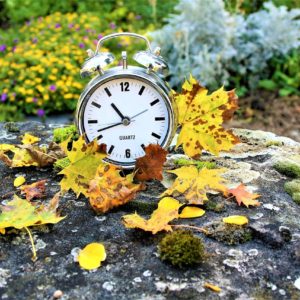If you read my last post, you’ll know that I have a really ugly pile of rubble at the end of my lawn, where the ground slopes towards the last part of my front garden. The rubble is visible to one side only, as it’s on a lower level to the lawn. It’s this lack of visibility from the house and the main part of the front garden, which has enabled me to survive with the existence of such a disaster in my yard for 3 years. But, with the placement of my rose hedge adjacent to this disastrous heap, its mere existence has been festering in my mind.
For the past 2 years, I’ve been making cuttings from my trusty Ajuga plant located on the rockery to the side of the heap of rubble that forms steps transitioning from the upper level to lower. That small purchase of either one or two tiny pots in a garden centre sale has spawned at least 50 other plants from cuttings. Last spring’s cuttings were planted in front of the rose hedge (located near to the stone steps) in late summer, and are doing really well. Last summer’s cuttings were potted up for the winter which they spent outdoors, as Ajuga is not just beautiful but also cold hardy. With the earth warming up and the growing season underway, they’re certainly ready to be transplanted to the general garden area.
I’ve decided to plant them on my rubble heap as the rose hedge is adjacent to it, and there will be continuity to the eye that will join the two areas and make you want to spread your gaze a little. Well, at least that’s the hope and vision I have for this little pocket of the garden.

I won’t even try to animate the proceedings at the very start of the process. I mean really, who gets excited about scrabbling about in rubble? I made myself emerge into the garden one day between rain showers, making that window of dryness my trigger point.
Now, it is very true that the best time to transplant anything is right before a period of light drizzle. With overcast skies and between spots of prolonged drizzle the trauma to the plant being transplanted will be minimized, as it won’t have to deal with dry soil or the scorch from the sun as well as being handled and planted somewhere new. So, I propelled myself outdoors and gave myself a good talking to for a quick 10 seconds. Then I approached the rubble heap.
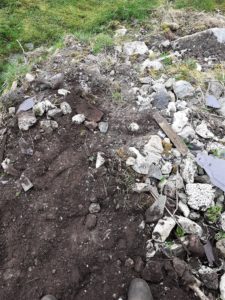
With no embellishments and all truth, I will admit to standing up and giving the rubble heap a tentative kick or three to see what would happen. Really, I’d spent so many days harvesting rocks from the ground, and hefting them out of the area so that I could create a good growing space for my plants, that I wasn’t looking forward to hefting more. I didn’t want to heft anything at this point really. My day spent weeding the day before had been a welcome break from the hoe-picking activity in the front corner-garden and I wasn’t ready to go back to it now, not even for a 2 hour stint between showers. To my surprise, the loose earth and small stones started to fall away, leaving patches of earth visible between the larger boulders. This gave me some immediate hope, and a surge of motivation. Maybe I could clear the surface and plant my ground cover today!
I started scrabbling and clearing with my hands – all gloved up, of course! With a heap of rubble and weeds forming around my knees, the original disastrous heap of builder’s rubble was being smoothed over on the surface, and started looking a bit tidier. The Ajuga got planted.
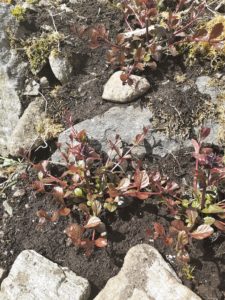
From even a short distance, the heap of rubble still doesn’t look like much, but it does look neater. As the Ajuga leaves are dark purple, they are a bit hard to distinguish from the exposed soil at the moment. But, there are things I can do to create even more interest in this rubble heap – just not today between rain showers. Maybe I’ll plant some bulbs or place other plants in the area. I’ll have think about it carefully and do a bit of observation, after all Ajuga is a ground cover plant and I don’t want it to smother anything else I plant. With the raindrops starting I headed indoors, quite pleased with myself for doing what I needed to do, even though I hadn’t really been in the mood.
The following day I knew I had to survey the scene of the prior day’s scrabble. It looked okay, neater than before, but certainly not yet a point of beauty. It was at that moment that I realized that I actually wanted to challenge myself to create a most definite point of focus from this heap of rubble.
Why, oh why, does my brain give me these ideas? As soon as the realization hit, I knew I was going to have this niggling voice in my head running through options and possibilities for the beautification of this bastard heap of rubble!
However, the work at hand for the moment was obvious. I needed to clear away the scrabble of rubble I’d pawed off the large eyesore. So, I got to work with the barrow. After about 5 of 6 barrow loads, the area was clear. And it was underwhelming to the eye.
I just stood and stared. I wanted to do something. I had to do something and the voice in my head wouldn’t let me let it go. My mind started racing as I went through some basic questions that always help me focus:
- What’s the problem you’re looking at?
- What will maintenance look like in this area? Can you foresee any problems with maintenance?
- What’s the goal here?
- What’s the current season of interest of the plants?
- What have you got already in your possession that will help with the problem?
Here was the result of my analysis.
I was looking at an undefined, yet tidy mound transitioning one level of the garden to another. It was an underwhelming site because it was just newly planted and the ground cover chosen possessed a dark, purple leaf which was blending into the brown of the soil. The ground cover would eventually knit together on the heap, but it would grow into the grassy flat edge at its base. The ground around the heap of rubble was flattish but not large enough to use a lawnmower, so a strimmer would be used to keep the grass cut. This would mean grass cuttings would fly everywhere and the edge of the ground cover, at the base of the rubble, would look a bit undefined and messy. I would need to define this base somehow, so any viewer would understand that this heap was a planned point of focus. The Ajuga’s foliage is lovely all year round, especially when contrasted to greens of other plants and its blue flower blooms in mid to late spring. So, for the rest of the year it would just be the foliage drawing interest.
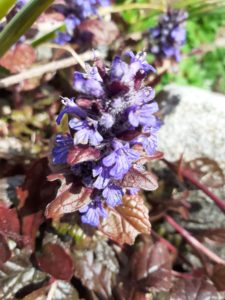
As you can see, there are some immediate problems until the ground cover knits together. But, I had two scrap pieces of wooden log edging that had been used last year to define the edge of the driveway rockery from the general lawn area. It works well in defining the two areas and protects the rockery from any mishaps from the use of the strimmer. Luck was definitely on my side as placed together, these two scraps of edging was the exact amount needed to create a circular-edge delineation at the base of the rubble heap.

And, that’s as far as I’ve got with the execution of ideas for this spot. I checked the weather forecast and saw that a two day storm was going to land the next day with gale force winds of nearly 60mph. I live in a terribly wild and exposed part of Scotland! This meant that I had to crack on after dinner and do a few jobs in a rush, so that my seedlings would live, be protected and even thrive.

After planting out a few stressed Limnanthes that were getting a bit too big for their pots, re-potting my Nasturtiums (there was no way I had the time to plant them out in their designated spot) and some other little plants, transplanting my baby sunflowers and moving about 500 seedlings either into my dinky garden shed or down from my outdoor seedling table, I decided I had done all I could and it was time to head indoors. It was nearly 8pm and I was tired.
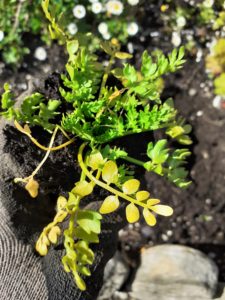
My mind, however, is still racing with problem solving ideas for the base of my heap of rubble. I fall asleep at night to thoughts of Euphorbia, Sedum, Daisies and many other plants that could be successfully added to the Ajuga to create year-round interest to my heap of rubble. I’ll see what I can do from seeds I already have and the cuttings I can make from already-established plants I have in other parts of the garden.
It’s very much a ‘watch this space’ on this heap of rubble. Then again, I suppose it’s that for the ‘front corner-garden’ project and for the ‘cluster of flowerbeds’ project too. Oh and for the veg patches as well. Ha! Just call me the Garden Fiend! Garden Gypsy? Garden Fairy? (Snort). Right, let’s just agree that I’m gardening mad and move on!




